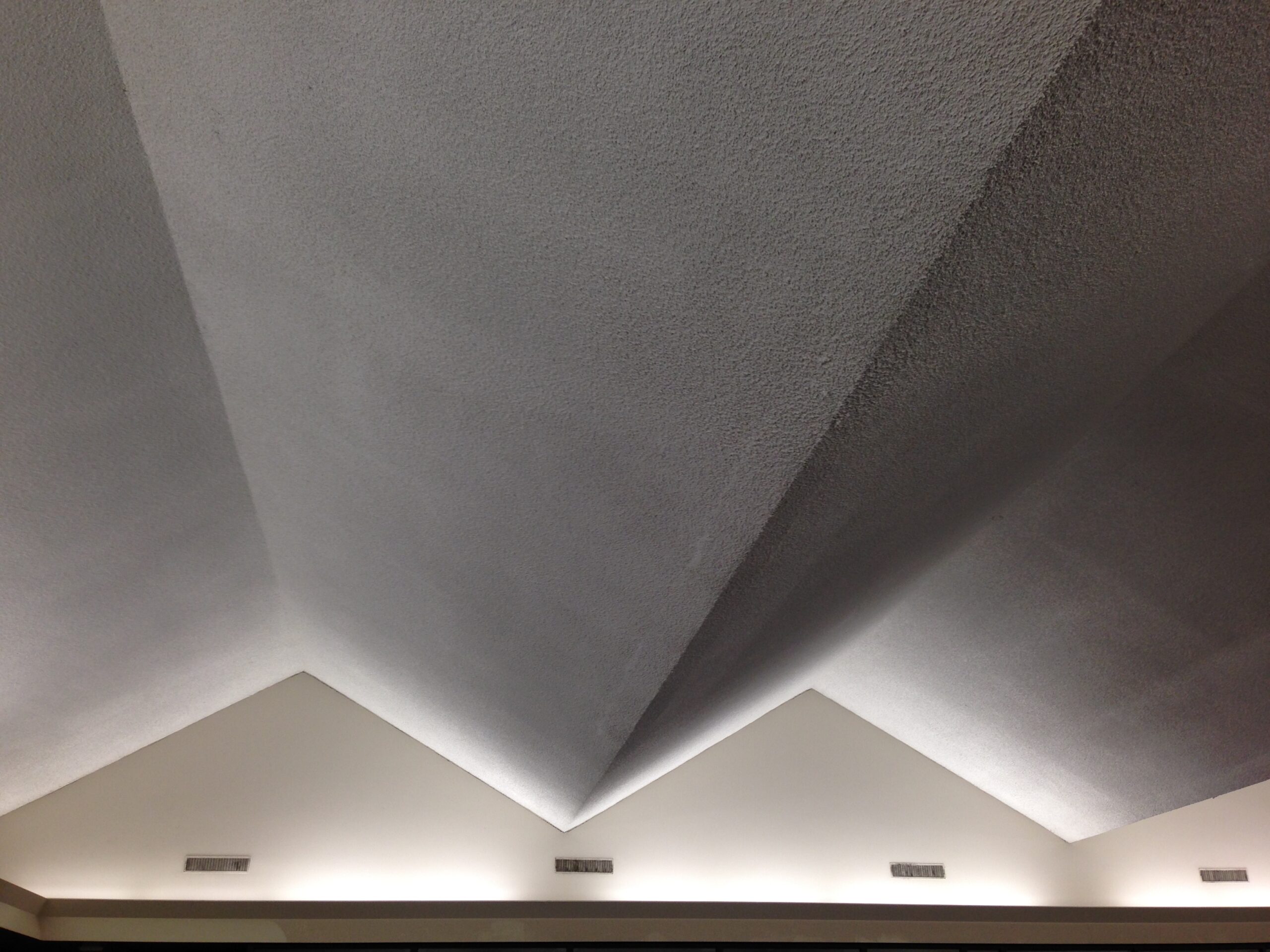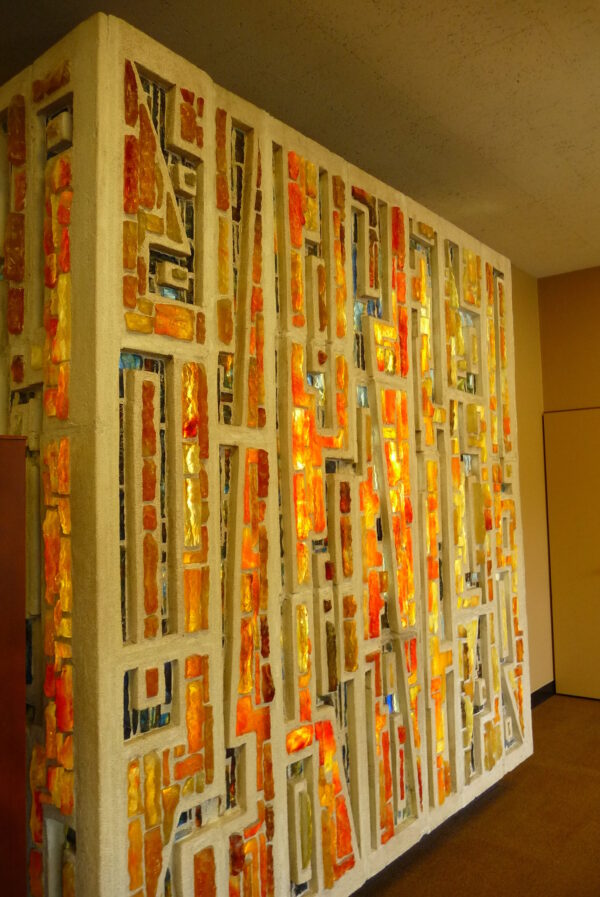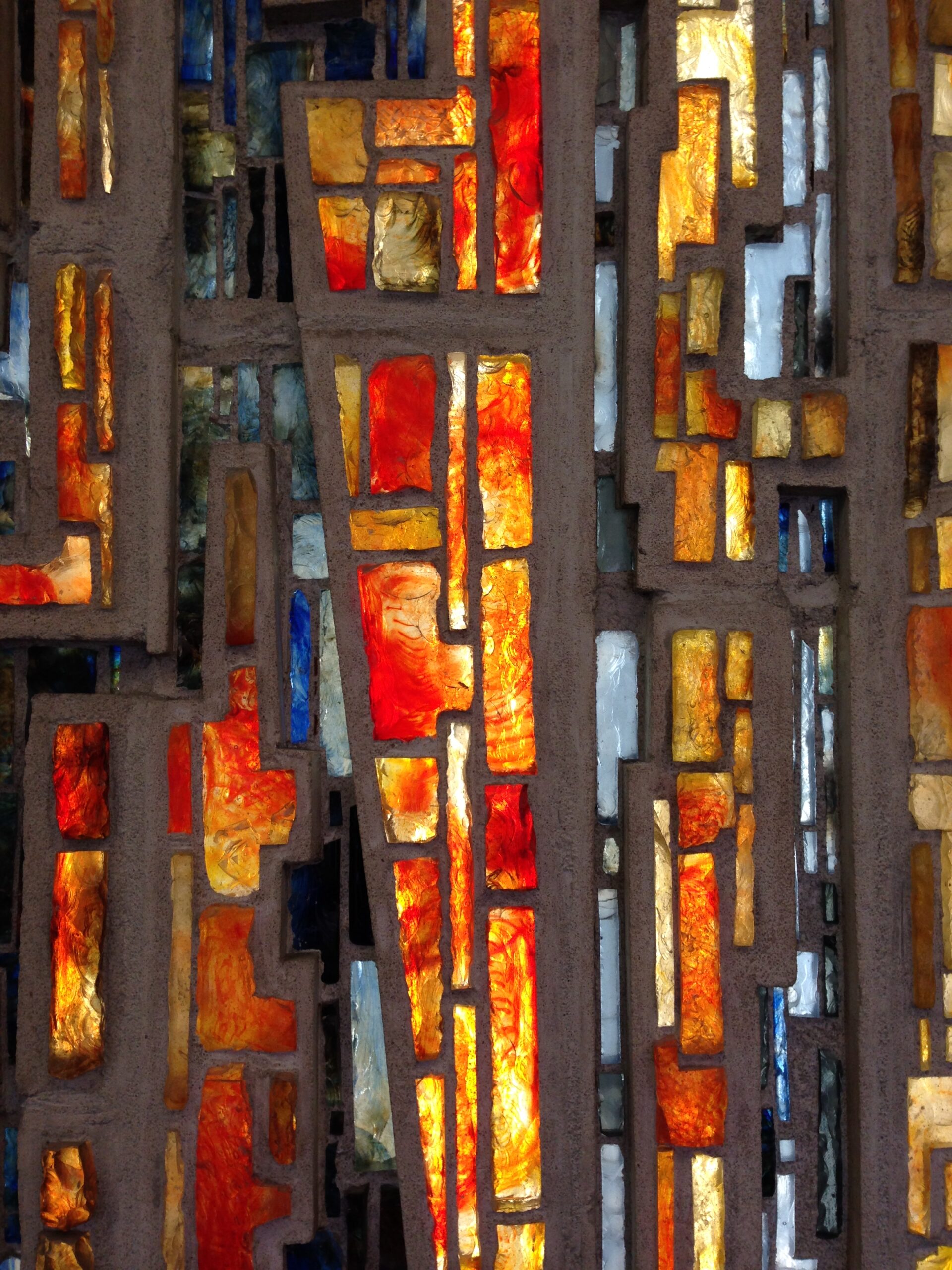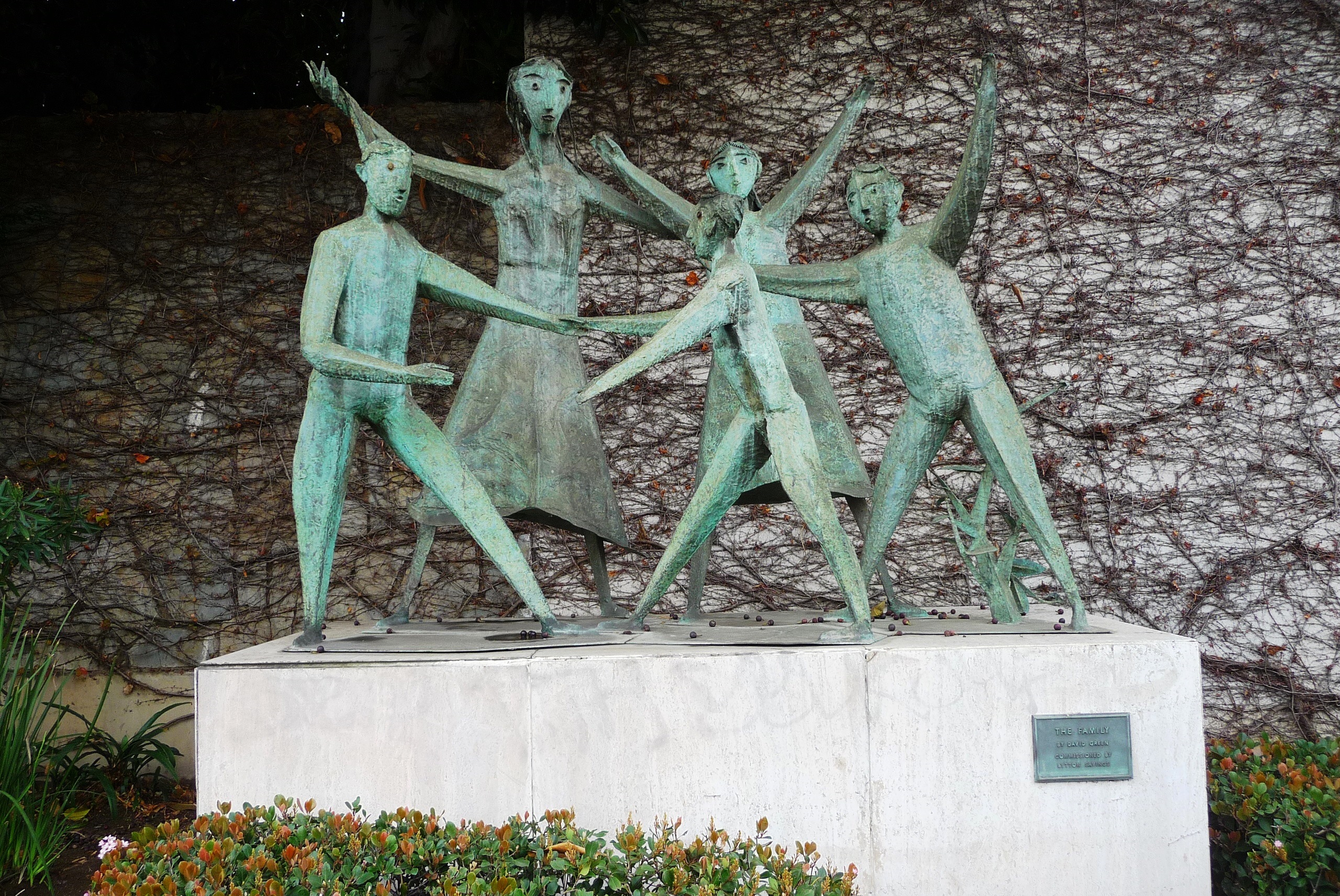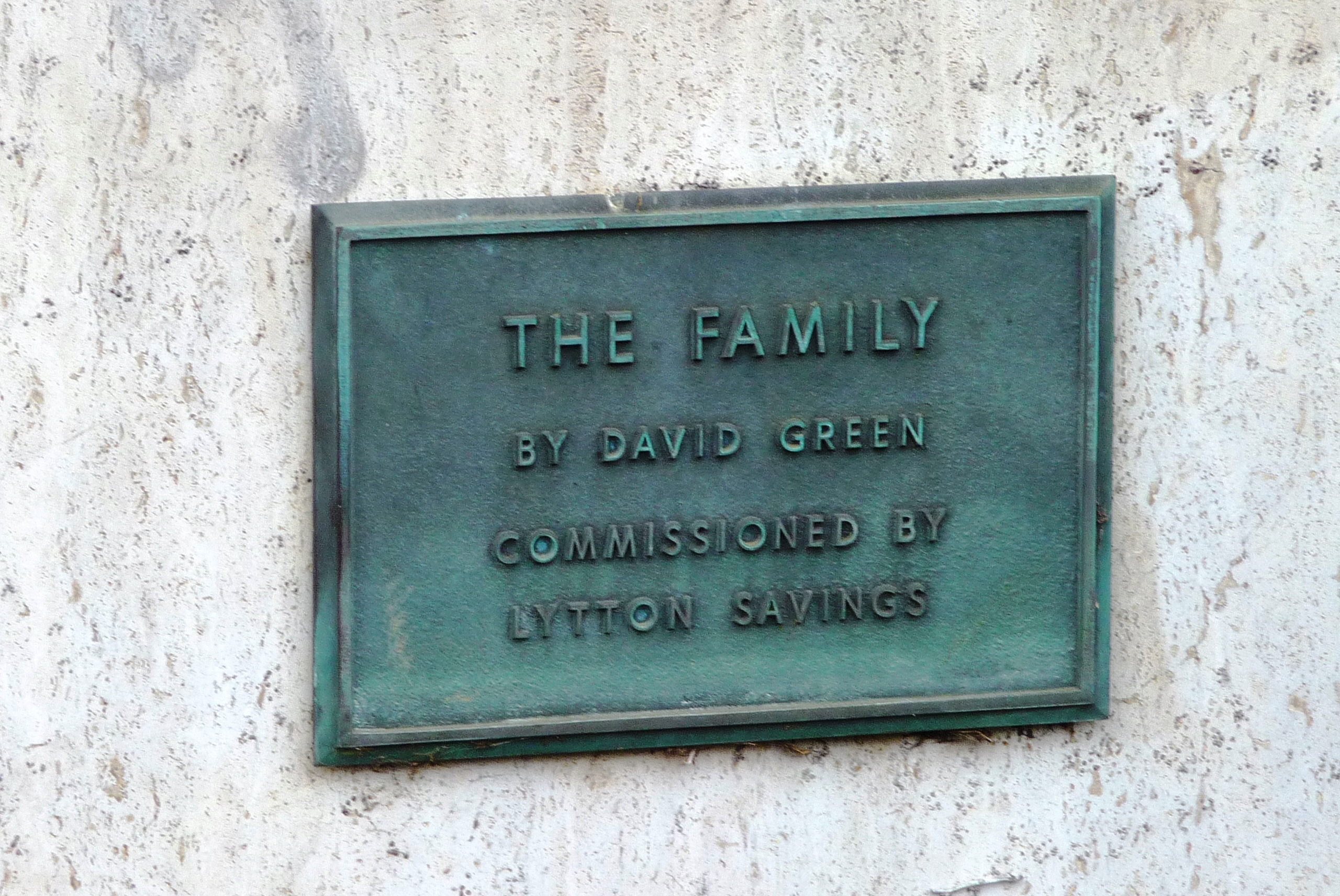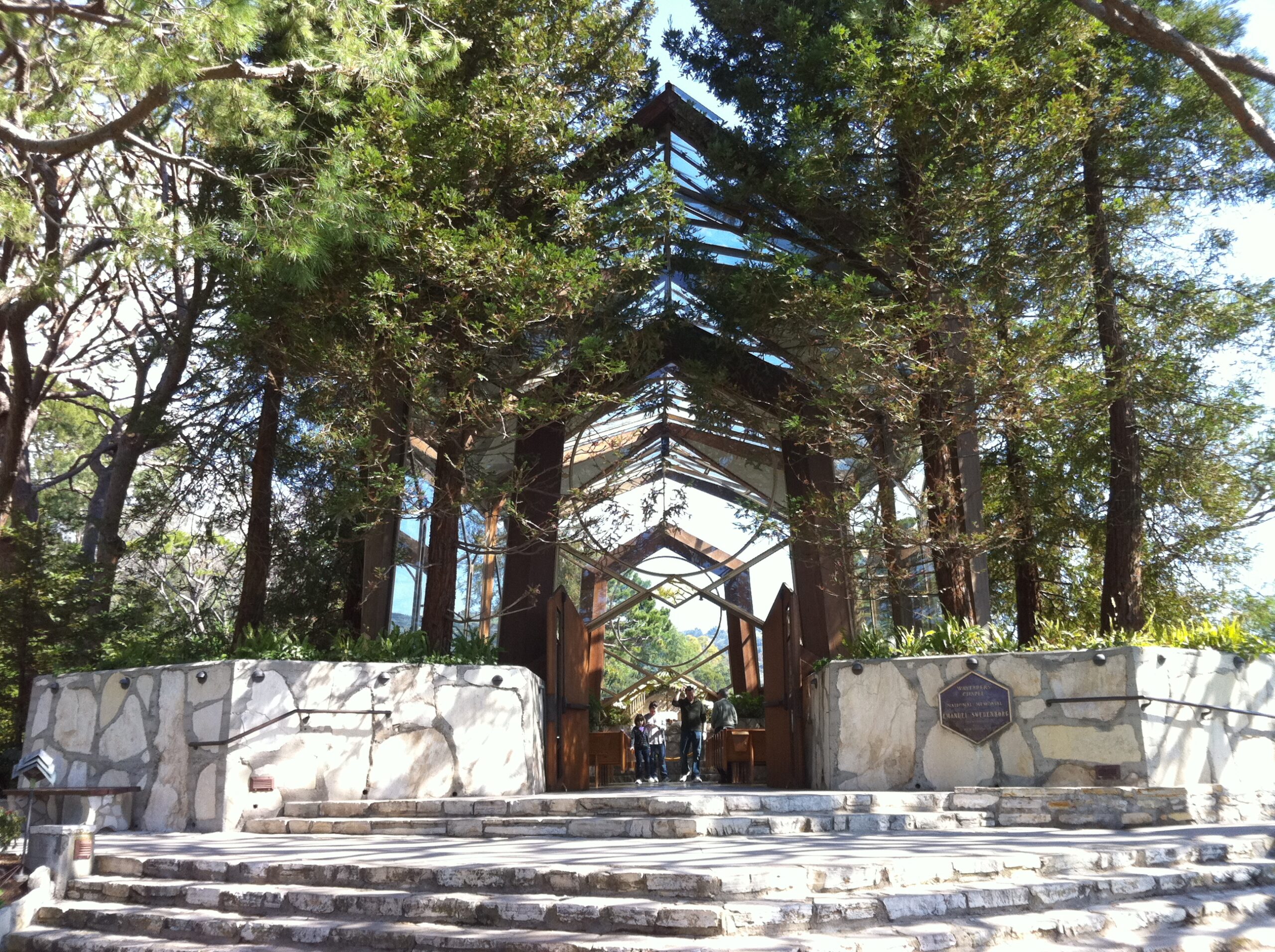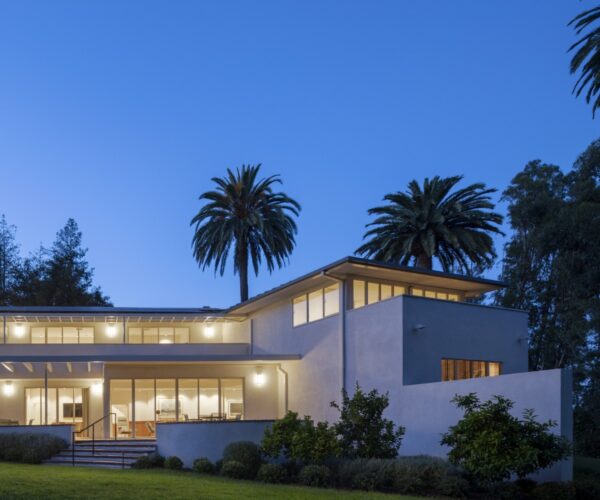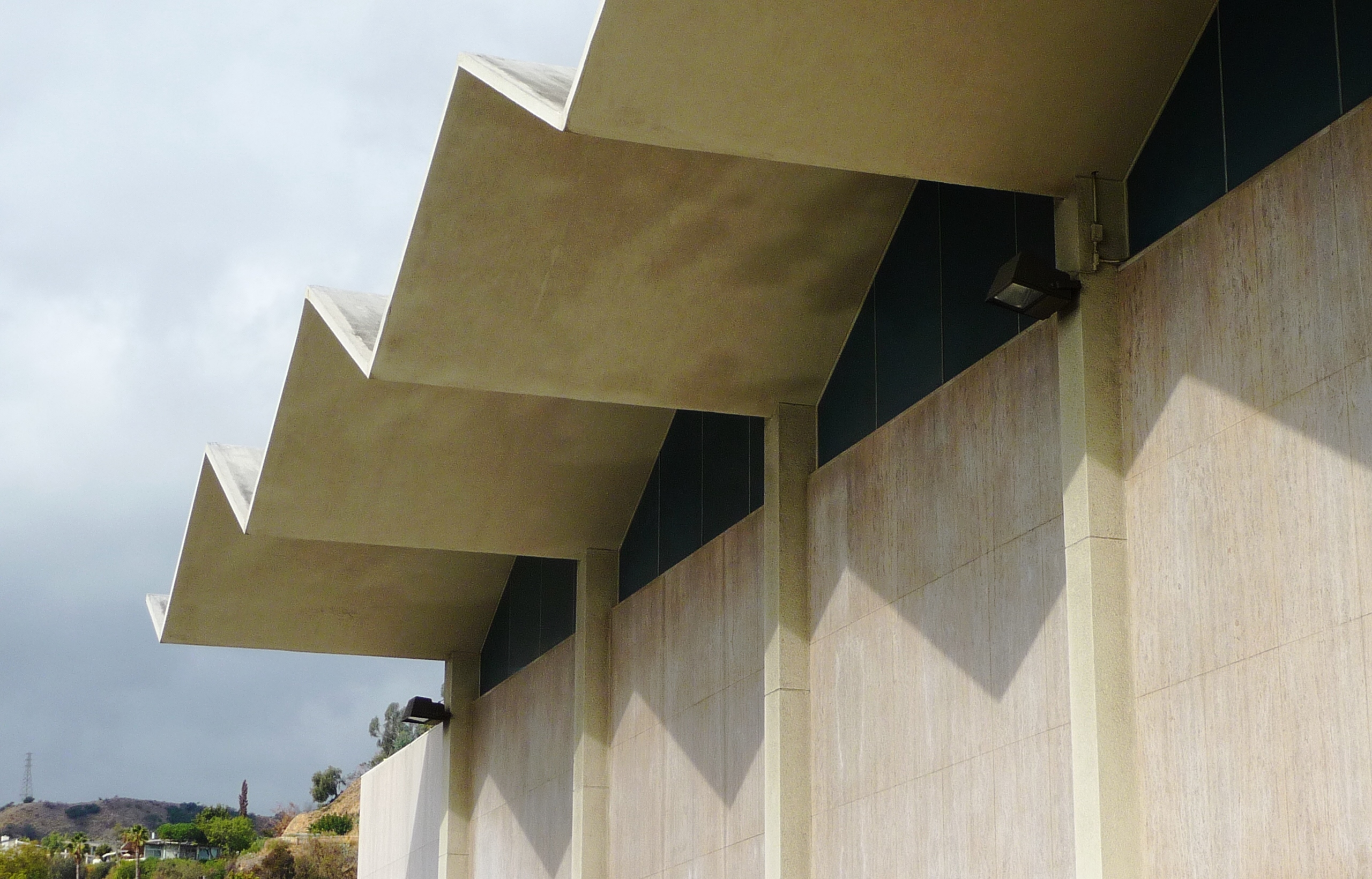
Place
Chase Bank/Lytton Savings, Hollywood (Demolished)
With its dramatic, folded plate concrete roof, the former Lytton Savings was a striking departure from traditional bank design when it opened in 1960.
Lost
In April 2021, demolition commenced on Lytton Savings, marking an end to this Modernist Hollywood landmark.


Place Details
Address
Get directions
Architect
Year
Style
Decade
Property Type
Government Officials
Community
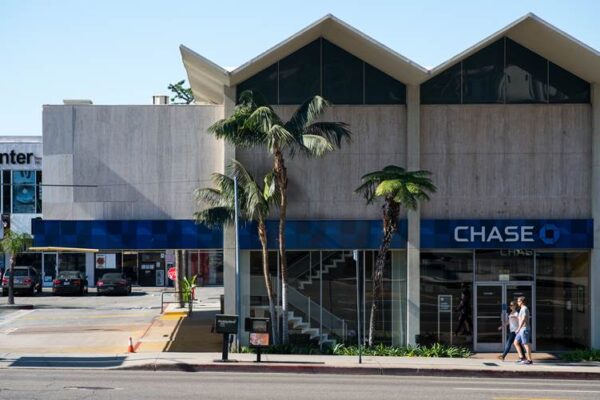
Detail, folded plate roof | Hunter Kerhart
Overview
Completed in 1960, Lytton Savings exemplified a transformative shift in bank design after World War II. As the EIR explains, the bank design “was strategically conceived as a modern multi-media showcase for Modern art, architecture, and interior design … related directly to its Sunset Boulevard context” with a “distinctive folded plate concrete roof.”
It was designed by the late Kurt W. Meyer, FAIA, a renowned architect devoted to public service and historic preservation. He served as chair of the Community Redevelopment Agency of Los Angeles, worked with financier Bart Lytton to try and preserve Irving Gill’s Dodge House (ultimately demolished) in West Hollywood, and served on the Conservancy’s first advisory council. In 2021 Lytton Savings was demolished.
In 2023, news was announced that developers, Townscape Partners, and their consultant team who helped facilitate the demolition of Lytton Savings, will not be following through with their approved plan to build at this site. Instead, the site is marketed for sale.
This further illustrates a flawed development process in the City of Los Angeles whereby historic buildings, in this case a designated Historic-Cultural Monument (HCM), is demolished in favor of flawed and inaccurate arguments supporting a replacement project that never materializes. As a result, this leaves the city with an empty lot, broken promises, and lost heritage.
Until the City addresses this loophole that rewards property owners who routinely clear sites of historic resources, in anticipation of future development that may or may not occur, we will continue to see historic places and our heritage needlessly lost.
About This Place
About This Place
As financial institutions nationwide analyzed the need for progressive banking methods following World War II, architects responded by radically reinventing the bank’s form. Lytton Savings (as part of larger Lytton Center) typified these national postwar banking trends through its modern architectural design, transparency, and integrated art component, and is one of Los Angeles’ earliest remaining examples of this transformative shift in postwar-era bank design.
Located at the corner of Sunset and Crescent Heights Boulevards at the western edge of Hollywood, Lytton Savings and larger Lytton Center occupies the former site of the Garden of Allah; the storied Hollywood inn with surrounding villas was purchased by Lytton in 1959 and razed to make way for the firm’s new home office.
Lytton Savings typifies the national banking trends in the postwar years. Lytton Savings, like Home Savings, California Federal, Great Western, and others, was a savings and loan financial institution that grew after World War II as an alternative to traditional banks. The savings and loans specialized in long-term personal lending, like savings accounts, certificates of deposits, and home mortgages, in contrast to traditional banks that focused on commercial and business clients.
Savings and loans were in high demand in the postwar years, as they financed the massive residential development boom. Their growth, along with the growth of the region, translated to the need for increased office space. Lytton Savings constructed the building on Sunset Boulevard as a new home office (as part of the larger Lytton Center), reflecting its modernity in the architectural design, transparency, and integrated art component. It was one of Los Angeles’ earliest remaining examples of this transformative shift in postwar-era bank design.
Company president Bart Lytton, an enthusiastic supporter of the arts, selected architect Kurt W. Meyer of the firm Hagman & Meyer, along with interior designer Adele Faulkner. Meyer’s design is unabashedly modern, using contrasting building materials and modernist forms. The building’s folded plate concrete roof, supported by slender vertical piers, caps a glass-walled façade of clerestories and ground-floor glazing offset by a mid-level band of book-matched, polished travertine that wraps around the building’s front and sides. Bouquet Canyon stone provided a contrasting texture on first floor walls flanking the central, glass-walled façade.
The building’s three-level interior was divided into a full-height banking floor inside the Sunset Boulevard entrance, which receives natural light from the clerestories and expansive glazing along the ground floor, and two upper levels of office and administrative spaces located beyond the banking floor.
The more prominent of postwar-era bank buildings popularized the integration of abstract art components in the 1960s. At Lytton Savings, the banking floor contained a monumental dalle de verre (faceted glass) and concrete screen designed by acclaimed artist-craftsman Roger Darricarrere, who was one of the first practitioners of this type of stained glass technique in the United States.
The 8 foot by 50 foot screen, which is significant as Darricarrere’s first commercial commission, was illuminated internally and serves both as an integrated component of abstract art and to separate the ground level public area from that containing the executive offices. Darricarrere later designed the monumental skylight for the now-demolished Columbia Savings Building on the Miracle Mile.
Following Lytton Savings’ completion in 1960, a commercial phase of development commenced at the rear of the site with the construction of a retail plaza, though a 12-story office tower proposed to rise above the plaza shops was never built. Lytton Savings later operated as a branch of Great Western Savings and more recently as Washington Mutual before being acquired by Chase.
Lytton Savings was a significant example of postwar-era bank design in Los Angeles. Other notable postwar-era bank structures by Meyer’s architecture firm, which became Kurt Meyer and Associates in 1963, include the Pomona regional office of Lytton Savings (1964) and the New Formalist style Financial Savings Building in Culver City (1966). His Brutalist style Liberty Savings Building in West Los Angeles (1966), which is a seven-story office tower, is significant for its use of concrete.
Efforts to Save Lytton Savings
In 2014, developer Townscape Partners proposed redeveloping the southwest corner of Sunset and Crescent Heights Boulevards with 229 apartment units (with 26 affordable units, 12 workforce units) and over 65,000 square feet of commercial retail and restaurant uses. The original project would span two buildings ranging from two stories up to 178 feet in height, with 494 subterranean and semi-subterranean parking spaces.
The Conservancy met with the developer to explore options for developing the site that would integrate the historic Lytton Savings building. Discussions were promising, with the developer initially open to reusing the historic building as part of the new development. Yet discussions ended after a new design by architect Frank Gehry was unveiled in August 2015.
In September 2015, the City of Los Angeles published Recirculated Portions of the Draft Environmental Impact Report, which evaluated the new project alternative designed by Gehry (“Enhanced View Corridor and Additional Underground Parking Alternative”). The alternative does not include preservation of Lytton Savings.
The Conservancy submitted comments on the Recirculated Draft EIR in October 2015. The Final EIR was published in May 2016.
On July 28, 2016, the City Planning Commission (CPC) held a public hearing on the 8150 Sunset Project. Despite some opposition regarding the proposed loss of the Lytton Savings building, the Commission voted in full support for the proposed project. The City continued to ignore identified preservation alternatives that meet most project objectives. The preservation alternatives allow Lytton Savings to be integrated as part of the proposed project.
Despite the Environmental Impact Report analysis, City staff proposed contrary findings to support a determination that preservation alternatives are infeasible, yet they provided no substantial evidence supporting these claims. An applicant’s preference to start from a clean slate and not integrate a historic building is not a relevant factor in determining the feasibility of the preservation alternatives.
The Conservancy submitted a letter from attorneys Chatten-Brown & Carstens outlining our concerns with the City’s adherence to the California Environmental Quality Act (CEQA) process.
On September 15, 2016, the City’s Cultural Heritage Commission (CHC) strongly supported a nomination by the Friends of Lytton Savings to list Lytton Savings as a Historic-Cultural Monument (HCM). To learn more, read the final staff report and recommendation. Councilmember David Ryu’s office initially supported the nomination.
On October 25, 2016, after several hours of public testimony, the City Council’s Planning and Land Use Management (PLUM) Committee also voted in support of the proposed project. Rather than hear the pending nomination to designate Lytton Savings as a Historic-Cultural Monument (HCM), PLUM members decided to postpone any discussion about the landmark status, instead placing it on their November 22 meeting schedule.
The Conservancy, the Friends of Lytton Savings, and numerous supporters attended the PLUM Committee hearing, pressing PLUM members and City Councilmember David Ryu to consider alternatives.
On November 1, 2016, the Los Angeles City Council voted in unanimous support of the 8150 Sunset project, including the demolition of Lytton Savings.
On December 13, 2016, the City Council voted to approve the HCM nomination. The Conservancy thanks then-Councilmember David Ryu for his leadership and support of the HCM, and to the Friends of Lytton Savings for spearheading this effort.
On December 1, 2016, the Conservancy sued to force the City of Los Angeles’ compliance with the California Environmental Quality Act (CEQA), where the Conservancy prevailed in Los Angeles Superior Court. This was subsequently overturned by the Court of Appeal.
In May 2018 the Conservancy petitioned the Supreme Court to review the recent Court of Appeal’s decision. That decision overturned the 2017 Los Angeles County Superior Court ruling in favor of the Conservancy and blocked the City of L.A. from demolition. On June 13, 2018, a decision by the Supreme Court of California to deny hearing a petition filed by the Los Angeles Conservancy effectively ended legal efforts to stop the needless demolition of the historic Lytton Savings building (now Chase Bank).
We respectfully disagreed with the Court of Appeal ruling, and believe this case goes to the foundation and intent of the California Environmental Quality Act (CEQA), and the need to fully consider and adopt preservation alternatives when feasible.
We were hopeful throughout the process, given the overwhelming evidence supporting our claim that development of the site could move forward without demolition of the historic building. The project’s Environmental Impact Report (EIR) acknowledged Lytton Savings as a qualified historical resource under CEQA.
Thank you to all who supported us in this effort, and to the Friends of Lytton Savings and then-Councilmember David Ryu.
Our Position
Lytton Savings was a significant example of postwar-era bank design in Los Angeles and one of the earliest that remained. We believed it was eligible for listing on the California Register of Historical Resources and was a Los Angeles Historic-Cultural Monument (HCM).
In our comments on the Recirculated Portions of the Draft Environmental Impact Report (RP-DEIR), we expressed our opposition to the demolition of an historic building that could otherwise be integrated and reused as part of the new development.
Given that the Final Environmental Impact Report (FEIR) demonstrated that feasible preservation alternatives existed that could incorporate the historic Lytton Savings building into a similarly sized mixed-use development, approval of the project as proposed violated the substantive mandate of the California Environmental Quality Act (CEQA).
The City lacked compelling evidence to support a claim that rejects viable preservation alternatives. CEQA is clear, concluding, “a statement of overriding considerations must include specific finding, supported by substantial evidence, that “[t]here is no feasible way to lessen or avoid the significant effect…” The vague and unsupported claims in the City’s findings do not provide the necessary evidentiary support to reject the less impactful preservation alternatives.
Preservation alternatives would have met the majority of the project objectives. Preservation alternatives are not required by CEQA to meet all project objectives. However, in this case, the City’s EIR concludes Preservation Alternatives 5 and 6 would fully meet twelve of the fifteen project objectives and partially meet the remaining three objectives.
The 1960 Modernist Lytton Savings/Chase Bank was designated as a City of Los Angeles Historic-Cultural Monument (HCM). We do not take the loss of an eligible or designated local landmark lightly, especially when it is not justified in order to proceed with a proposed project.
The Conservancy strongly urged the City to reject the proposed project, which called for the unwarranted and needless demolition of the historic Lytton Savings/Chase Bank. Preservation alternatives were identified and assessed for this project that were determined feasible and allowed for a “win-win” outcome that would have 1) avoided demolition; 2) fully met the majority of the project objectives; and, most importantly, 3) could have resulted in a project that would not violate CEQA.
The Conservancy and the many community groups and individuals that expressed serious concerns with the proposed project called for the developer and City to pursue viable alternatives. This was rejected and dismissed without merit.
Conservancy Filed Suit Against the City of Los Angeles
On December 1, 2016, the Conservancy sued to force the City of Los Angeles’ compliance with the California Environmental Quality Act (CEQA) in considering demolition of the historic Lytton Savings building (now Chase Bank) at 8150 Sunset Boulevard. A hearing occurred on April 19, 2017.
The Conservancy contended that the City blatantly disregarded environmental law in its review of the 8150 Sunset Boulevard Project, a mixed-use development proposed for the southwest corner of Sunset and Crescent Heights Boulevards.
While Lytton Savings was significant in and of itself, the litigation was about more than the building. We needed to hold the City of Los Angeles accountable for following the law. Otherwise, their actions set a dangerous precedent for future land-use decisions that will affect Angelenos for years to come.
The environmental impact report (EIR) acknowledged Lytton Savings as a qualified historical resource. The EIR identified two feasible preservation alternatives allowing Lytton Savings to be incorporated into the project. Under CEQA, a project must avoid significant impacts such as the demolition of a historical resource if the fundamental project objectives can be met without demolition.
Nonetheless, the Los Angeles City Council approved the project that, as designed by architect Frank Gehry, called for the needless demolition of Lytton Savings.
While the City claimed that the EIR’s preservation alternatives were not feasible, its findings were contradicted in the EIR and were not supported by any substantial evidence.
Early in the process, the Conservancy met with the developer, Townscape Partners, who responded positively to the idea of integrating Lytton Savings as part of the new development. This promising collaboration came to a halt after a new design for the site by Gehry was unveiled in 2015. This new design was ultimately approved.
The EIR included two viable preservation alternatives that meet nearly all of the project objectives. Why were they not discussed by the City, at the City Planning Commission, the Planning and Land Use Management (PLUM) Committee, or City Council?
In March 2018, California’s 2nd District Court of Appeal overturned the 2017 Los Angeles County Superior Court ruling which blocked the City of L.A. from demolishing the landmarked Lytton Savings building.
On April 25, 2017, Los Angeles Superior Court Judge Amy Hogue ruled in favor of the Conservancy in our public interest lawsuit to stop the needless demolition of the historic Lytton Savings building (now Chase Bank). Now a designated Historic-Cultural Monument, the 1960 building at 8150 Sunset Boulevard was proposed for demolition as part of a new mixed-use development.
“We’re very grateful for this decision, and we’re excited that the development project can move forward incorporating the historic Lytton Savings building,” said Linda Dishman, the Conservancy’s president and CEO.
“We’ve worked with many architects and developers to successfully integrate historic places into new development, and now that can happen here,” said Adrian Scott Fine, the Conservancy’s director of advocacy. “Blending old and new is the wave of the future in Los Angeles.”
The Court’s comprehensive ruling found that because the City’s approval of the Lytton Savings building’s demolition violated the California Environmental Quality Act (CEQA), a state law that protects California’s built environment as it does the natural environment, the project approval must be set aside.
The environmental impact report (EIR) for the 8150 Sunset Boulevard project studied two alternatives that included the historic building and determined that they would feasibly accomplish the project. The City later claimed that the preservation alternatives were not feasible and approved the building’s demolition.
The Conservancy did not challenge the adequacy of the project EIR. Conservancy attorney Susan Brandt-Hawley explained the significance of the Court’s ruling as, “The City Council abused its discretion and violated state law by approving this demolition of a historic resource. The loss of Lytton Savings would be a significant environmental impact, and it is feasible to instead avoid demolition and move ahead with the project.”
At 20,000 square feet, the Lytton Savings building represents only a small portion of the 330,000-square-foot development planned for the site. “The City Council already amended the project once after certifying the EIR,” said Dishman. “It can now amend the project again to accommodate this historic building, which represents just six percent of the project’s total square footage.”
Breaking the Cycle of Demolition
For some, Lytton Savings itself was associated with a lost historic landmark, as it occupied the former site of the Garden of Allah. The storied Hollywood inn with surrounding villas was purchased by Lytton Savings in 1959 and razed in part to make way for the firm’s new home office and a proposed new office development that was never built. The adjacent, now demolished, commercial strip development was not designed initially as part of Lytton Savings.
While the Garden of Allah was important, this layered history does not negate Lytton Center’s significance as a modern postwar bank, but it highlights one of the challenges in saving Modern and recent past resources with complicated pasts. Do we allow another historic place to be lost or rather do we break the cycle of demolition at this site?

